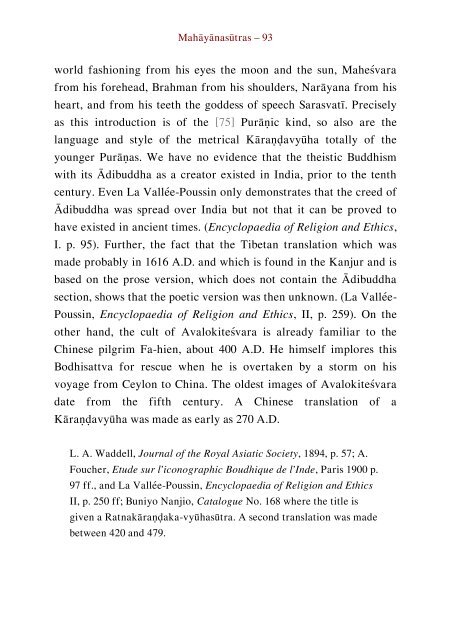Literary History of Sanskrit Buddhism
A study by J. K. Nariman of Sanskrit Buddhism from the Early Buddhist Tradition up to the Mahayana texts proper.
A study by J. K. Nariman of Sanskrit Buddhism from the Early Buddhist Tradition up to the Mahayana texts proper.
You also want an ePaper? Increase the reach of your titles
YUMPU automatically turns print PDFs into web optimized ePapers that Google loves.
Mahāyānasūtras – 93<br />
world fashioning from his eyes the moon and the sun, Maheśvara<br />
from his forehead, Brahman from his shoulders, Narāyana from his<br />
heart, and from his teeth the goddess <strong>of</strong> speech Sarasvatī. Precisely<br />
as this introduction is <strong>of</strong> the [75] Purāṇic kind, so also are the<br />
language and style <strong>of</strong> the metrical Kāraṇḍavyūha totally <strong>of</strong> the<br />
younger Purāṇas. We have no evidence that the theistic <strong>Buddhism</strong><br />
with its Ādibuddha as a creator existed in India, prior to the tenth<br />
century. Even La Vallée-Poussin only demonstrates that the creed <strong>of</strong><br />
Ādibuddha was spread over India but not that it can be proved to<br />
have existed in ancient times. (Encyclopaedia <strong>of</strong> Religion and Ethics,<br />
I. p. 95). Further, the fact that the Tibetan translation which was<br />
made probably in 1616 A.D. and which is found in the Kanjur and is<br />
based on the prose version, which does not contain the Ādibuddha<br />
section, shows that the poetic version was then unknown. (La Vallée-<br />
Poussin, Encyclopaedia <strong>of</strong> Religion and Ethics, II, p. 259). On the<br />
other hand, the cult <strong>of</strong> Avalokiteśvara is already familiar to the<br />
Chinese pilgrim Fa-hien, about 400 A.D. He himself implores this<br />
Bodhisattva for rescue when he is overtaken by a storm on his<br />
voyage from Ceylon to China. The oldest images <strong>of</strong> Avalokiteśvara<br />
date from the fifth century. A Chinese translation <strong>of</strong> a<br />
Kāraṇḍavyūha was made as early as 270 A.D.<br />
L. A. Waddell, Journal <strong>of</strong> the Royal Asiatic Society, 1894, p. 57; A.<br />
Foucher, Etude sur l’iconographic Boudhique de l’Inde, Paris 1900 p.<br />
97 ff., and La Vallée-Poussin, Encyclopaedia <strong>of</strong> Religion and Ethics<br />
II, p. 250 ff; Buniyo Nanjio, Catalogue No. 168 where the title is<br />
given a Ratnakāraṇḍaka-vyūhasūtra. A second translation was made<br />
between 420 and 479.


















